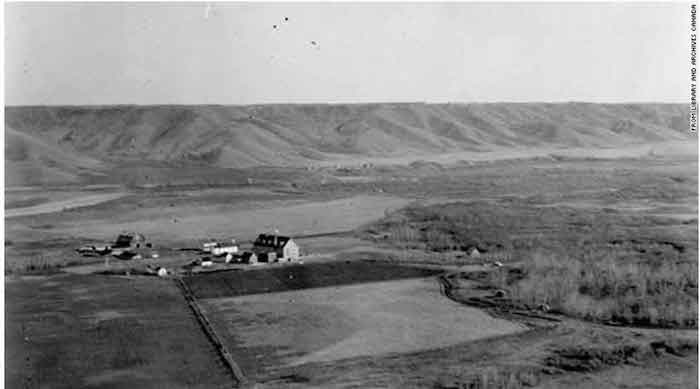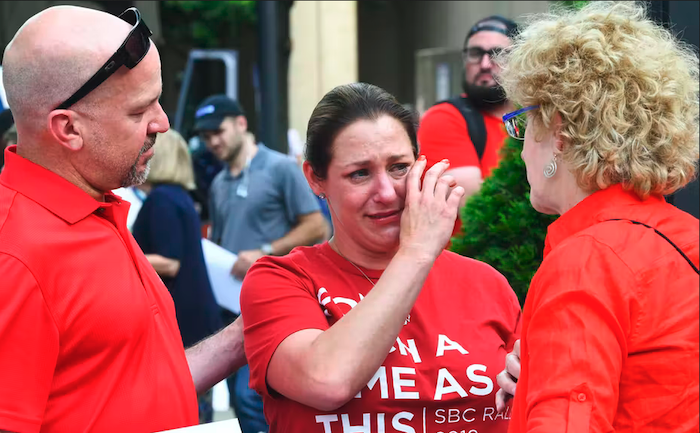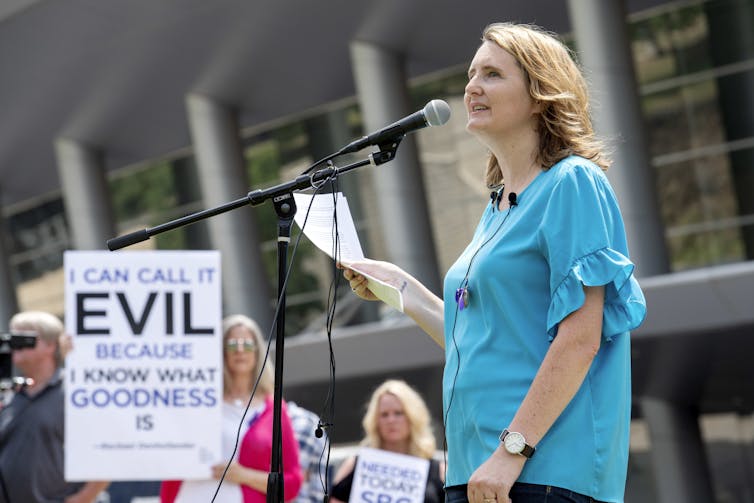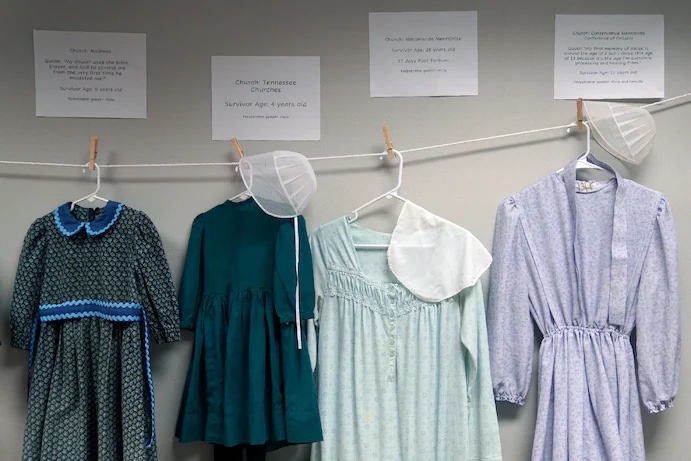Two brothers allege that Gary Mercure, a former priest convicted of raping boys in Massachusetts, had sexually abused them with former Albany bishop
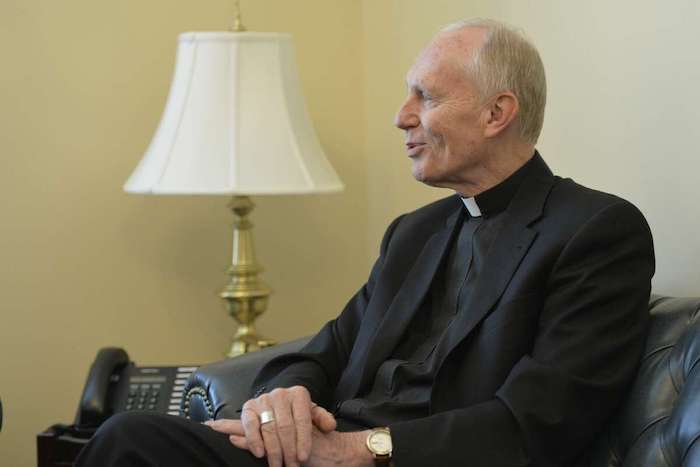
Two brothers who grew up in Warren County in a devout Catholic family allege that Gary Mercure, a former priest in their childhood parish who was later convicted of raping young boys in Massachusetts, had sexually abused them on multiple occasions over a period of years and that ex-Albany Bishop Howard J. Hubbard took part in some of the assaults.
In a series of recent interviews with the Times Union, the brothers recounted years of sexual abuse at the hands of Mercure beginning in the mid-1980s. They also had detailed those allegations when they testified at Mercure’s 2011 criminal trial in Pittsfield, where the former priest was sentenced to two decades in prison following his conviction on charges of raping two altar boys.
The men, now in their 40s, for the first time are publicly asserting that Mercure and Hubbard sexually abused the older brother on multiple occasions during encounters at Lake George motels, in the rectory of Our Lady of Annunciation in Queensbury, and in Mercure’s vehicle in Albany.
“The bishop forcefully denies the allegations; he’s never abused these gentlemen, never met these gentlemen, never abused anyone, whether it be a minor or an adult,” said Terence P. O’Connor, an Albany attorney whose firm is representing Hubbard in the sexual abuse cases. “The bishop wholeheartedly denies these allegations. He’s never abused either of these boys. He’s never abused anybody.”
The younger brother said he was sexually abused once by Hubbard, but that he — like his brother — had been sexually assaulted hundreds of times by Mercure beginning when they were about 8 years old and continuing into their high school years. Numerous other men, many of them former altar boys who worked alongside Mercure, also have leveled sexual abuse allegations against him.
The brothers asked to remain anonymous for this story. The Times Union does not identify alleged victims of sexual abuse without their consent.
The older brother said that “looking back on it now, it was almost as if Mercure was setting me up for the bishop to take over … especially going down to Albany or when the bishop would come into Lake George and come visit Mercure (at motels).”
Mercure had a close relationship with Hubbard, who has visited the former priest at the Massachusetts prison where he is serving his 20- to 25-year sentence, according to law enforcement sources.
The alleged abuse involving the bishop that took place in the rectory at Our Lady of Annunciation in Queensbury — a location where Mercure was also accused of sexually abusing other young boys — usually occurred in connection with events such as Christmas Mass or confirmation ceremonies. The older brother said Mercure would often ply him with money and alcohol, an allegation made by other alleged victims.
“John French, the pastor at that church, was constantly at odds with Mercure because kids — boys — were coming in and out of that rectory at Annunciation, and he had a strict policy that we were not supposed to be in that rectory,” the older brother said. “So Mercure went out of his way to make sure that French was out of there or gone when him and Hubbard were there doing their thing.”
He said that Mercure on occasion drove him to Albany and they would pick up Hubbard and drive into a park — he described a setting that appeared to resemble Washington Park — and pick up male prostitutes or men interested in having sex with strangers. He said those men would never have sex with him, but that Mercure and Hubbard would perform sexual acts in front of him.
He said that during the car trips to Albany, when he said he was also occasionally sexually abused by the priest and bishop, “I never was allowed inside where the bishop was. … I was always in the car or he would meet us someplace, sometimes a restaurant … but I could never go into the chancery.”
The older brother said that during the alleged encounters at Lake George motels, Hubbard maintained a low profile but Mercure often went out in public dressed like a tourist and without wearing his clergy collar. He said there were multiple sexual encounters in those motels involving the bishop, who would then leave quickly. The older brother said Mercure would sometimes hand him hundreds of dollars or take him out to dinner after the alleged incidents.
During one of the visits, the older brother said, Mercure and Hubbard got into an argument after they ran into people who knew Mercure. “The bishop was saying it was drawing too much attention — ‘You’re asking for trouble,’ ” the older brother recalled. “Hubbard had made comments that I overheard about how careless Mercure was about all this.”
Years to process
The new allegations against Hubbard have increased the number of individuals accusing him of sexual abuse to at least nine — seven of whom have filed lawsuits against the former bishop, the Catholic church or the Albany diocese. The lawsuits, among hundreds pending against the diocese, were filed under New York’s Child Victims Act, which lifted the statute of limitations for two years to give alleged victims the opportunity to sue their abusers or the institutions that may have harbored them.
O’Connor, Hubbard’s attorney, noted that an attorney for the brothers had reported their allegations against Mercure to the diocese in 2008, but had never told the organization about the allegations against Hubbard, including in the ensuing years when that attorney negotiated to have their counseling fees paid by the church.
“I would think that would have been a ripe time to raise the allegations,” O’Connor said. He highlighted another man’s allegation that Hubbard had abused him on a bus during halftime of an Army-Navy game at West Point Academy. O’Connor noted that before 2020, Army and Navy had not played a game at West Point since the 1940s.
The older brother said that in 2008, their family was in the midst of his father’s decadelong battle with a health condition that would later cause his death. He said O’Connor may not understand the complexities of suppressing the memories of childhood sexual abuse and dealing with a diocese that had never reached out to apologize to the many victims that Mercure was accused of raping when they were children.
He said that after he and his brother testified at Mercure’s criminal trial in Massachusetts, diocesan representatives, including two who attended the trial, did not thank them for their testimony that had helped secure the former priest’s conviction. He said that when Hubbard conducted a “healing” mass at Our Lady of Annunciation in Queensbury following Mercure’s criminal trial, the bishop never mentioned the victims — even though much of the sexual abuse occurred in an adjacent room.
“You have a man that’s been accused of multiple allegations throughout the years and the best question that (his) attorney has is, ‘Why didn’t they tell us about this sooner?’ ” the older brother said. “Not one time has there been any call from the bishop or anyone high up in that diocese apologizing or saying, ‘Thank you for getting up there and testifying and helping put this guy away where he belongs, because this is something we should have stopped years ago.’ ”
He said it’s noteworthy that Hubbard, who has acknowledged concealing clergy abuse and returning abusive priests to ministry after they had received counseling, has visited Mercure in prison but never reached out to the alleged victims of Mercure’s abuse.
There was an earlier — but cryptic — disclosure to the diocese about his allegation against Hubbard: The older brother’s claim of a second clergy member abusing him was shared with the diocese in 2014, when his attorney notified Michael L. Costello, the longtime attorney for the diocese, of a second abuser that the brother did not want to identify, according to letters exchanged between the attorneys.
The brothers’ attorney at that time, Tina Weber, said the older brother was not ready to come forward then about his allegations against Hubbard and, apparently because of that, Costello cut off communication with her for about two years. Costello, in a 2016 letter to Weber, noted he had raised concerns that the unidentified clergy member could victimize others, and he cited a memorandum of understanding between the diocese and New York’s district attorneys that required the church to notify them of any new sexual abuse allegations.
The older brother said that even though the diocese paid him and his brother $90,000 each in 2016 to cover their counseling, that agreement — which did not include compensation for “pain and suffering” — came only after they had endured years of the diocese allegedly failing to pay for their therapy sessions in a timely manner. The delays often required their attorney to have to call and demand payments be made. In addition, he said, the diocese tried to pressure them to sign a release enabling the church to receive copies of their therapists’ notes and other treatment records.
“They’re asking me to come forward and other people to come forward when Hubbard was still bishop? What do you think is going to happen?” the older brother said. “And their track record isn’t very good for how they’ve handled these accusations before in the past.”
The brothers said that when the allegations against Mercure were made public more than 14 years ago, they interpreted many of the public statements made by diocesan officials as implying that his sexual abuse of children involved isolated incidents and that his alleged victims were teenage boys experimenting with homosexual sex.
“We were getting beat up and lambasted like we did something wrong. We were kids — what did we do wrong?” the older brother said. “Why is Hubbard going down to that prison to visit (Mercure) instead of calling Tina to say, ‘What do your (clients) need?’ … It doesn’t give a victim a very good feeling that it’s OK for me now to come forward.”
‘Bad eggs’
The brothers recently agreed to tell their story publicly, they said, in part because of the manner in which they contend the Roman Catholic Diocese of Albany has waged a fierce legal battle to have their Child Victims Act lawsuit against the diocese and Our Lady of Annunciation thrown out of court.
The dismissal, which was affirmed by a mid-level appellate court but may be reviewed by the state Court of Appeals, centered on the diocese’s argument that the pair had relinquished any future claims for the abuse they endured when they signed an agreement in 2016 to receive the $90,000 payments for trauma therapy.
In a letter to their attorney, Costello described the diocese’s practice of requiring a “general release … which is intended to provide partial counseling and associated expenses permitting the victim to advance with healing and their lives.”
But, he added in the letter, “the limited assistance provided covers past/prospective counseling and indirectly recognizes pain and suffering through the counseling. Assistance resolution does not earmark or compensate explicitly for pain and suffering.”
Even though the Child Victims Act at that time had been stalled for years in the state Legislature, and with no indication it would pass, the brothers said they would not have signed that release if they thought it would have barred them from any future claims against the diocese.
“They treated (the brothers) almost like criminals during and after (Mercure’s criminal trial),” Weber said. “What they wanted is periodically to review what was going on, before they would authorize additional counseling sessions, which is why finally at one point (the brothers) said, ‘Can we just settle this somehow?’ That’s how the counseling package came into play: so they never had to deal with the diocese again.”
Kathryn Barrans, a spokeswoman for the diocese, said they have “provided considerable assistance to the victims/survivors in this case.”
“Prior to the settlement reached in 2016 with the victims/survivors and their attorney, the diocese provided payment for ongoing counseling assistance for them and a family member to the health care provider of their choice,” Barrans said. “The settlement, reached with the consent of their attorney, provided an additional $90,000 for each victim/survivor in this case.”
Weber countered that the diocese’s “go-to position has been, and always will be, victim shaming and blaming.”
“It is disingenuous, at best, to now suggest — both in court and in the court of public opinion — that my former clients received fair and just compensation,” Weber said. “It must be understood that the damage caused by the abuse as well as the dismissive actions of the diocese continues to traumatize my former clients on a daily basis.”
Last year, a lawsuit filed anonymously on behalf of a male plaintiff against the diocese and St. Edward the Confessor Roman Catholic Church alleged that in 1977 — the year Hubbard was appointed bishop — he approached the then-11-year-old boy at a carnival at the Clifton Park church and told the boy to accompany him to the rectory, and molested him.
“For a period of time I experienced a lot of anger toward religion, towards God, my beliefs,” the man who filed that lawsuit told the Times Union last year. “And over a period of time, I just realized that there’s just bad eggs. There’s certain people that are just rotten people, and Bishop Hubbard is just one of those people.”
Hubbard, who stepped down as bishop in 2014, issued a statement in response to the man’s lawsuit, saying: “I pray for the anonymous individual who filed this lawsuit that he will know the healing and peace of God’s love and will find the justice and closure he seeks. I know with absolute certainty that I did not abuse him because I know with absolute certainty that I have never abused a child or an adult, sexually or in any other way.”
In the Queensbury case, the younger brother said they were sexually abused by Mercure repeatedly over a period of about a decade beginning in the mid-1980s. He reiterated that Mercure and Hubbard had sexually abused him together only once, and that he and his brother did not know until years later, when they were adults, that they had both been victimized.
When asked why he was coming forward now, he said: “A lot of this is the frustration that there’s been zero accountability in the diocese. No convictions. The Child Victims Act is all smoke and mirrors. Hubbard continues to tell all these lies. It’s really hard to swallow. You get a lot of: ‘Just try to move on. You’re a male. It happened 30 years ago, get over it.’ But the effect it takes on your entire life — relationships, family, anxiety, nightmares.”
‘Dumbfounded’
Mercure was ordained in 1975 and served as a priest or associate pastor at St. Mary’s in Clinton Heights, St. Mary’s in Glens Falls, Our Lady of Annunciation in Queensbury and Our Lady of the Assumption in Latham.
In the mid-1990s, the diocese sent Mercure to a church-run hospital near Philadelphia, St. John Vianney, for undisclosed counseling and what church officials described as a “nervous breakdown.” That facility, according to a 2018 grand jury investigation by the Pennsylvania state attorney general’s office, was one of many facilities used by the Catholic church to secretly provide treatment to priests accused of sexually abusing children.
Mercure was visited by the brothers’ family members at St. John Vianney, where they thought he was being treated for anxiety. The parents were close to Mercure at Our Lady of Annunciation, where they had been eucharistic ministers and were unaware at the time of his alleged sexual abuse of their sons. During one of the family’s visits to the Downington, Pa., facility, Mercure allegedly fondled the younger brother after asking him to help carry some reading materials that he had received from the family to his room.
Years later, around 2000, the mother of two former altar boys contacted church officials and reported that her son had told her Mercure had once tried to kiss him on the family’s front porch.
The woman, who lives in another state and spoke to the Times Union several years ago on the condition she not be identified, said she was put in touch with Father Louis Deimeke, a diocese official who later retired.
“He wanted to know ‘What do you want from us?’ ” she said. “I said we don’t want any money. … I’m calling to protect other children.”
She said Deimeke acknowledged they’d “had problems” with Mercure.
Church officials would later say Mercure denied the allegations and resumed his ministry duties in Troy.
The woman said that about a year later she learned Deimeke would be at St. Mary’s Church in Glens Falls. She waited and followed him into the sacistry, where she introduced herself.
“He did not acknowledge me in any way, shape or form,” she said. “He continued to put his coat on and walked out the sacistry door and out of the church. I stood there dumbfounded.”
In 2008, after one her sons learned Mercure was still a priest at an area church affiliated with a school, he contacted then-Warren County District Attorney Kate Hogan and recounted years of alleged abuse at Mercure’s hands. On paper, it looked as though the New York statute of limitations barred any prosecution. But Hogan’s office investigated and learned Mercure had raped some of his victims in Massachusetts, where his crimes were not time-barred from prosecution.
Hubbard’s attorney last year told the Times Union that “people have come out of the woodwork” and filed lawsuits because they are looking to get money. The attorney acknowledged at the time that having seven accusers of Hubbard “doesn’t look great” but added that many of the “factual predicates of the lawsuits are completely ridiculous.”
Hubbard’s handling of sexual abuse in the diocese as bishop from 1977 to 2014 faced further scrutiny recently when it was revealed that he had testified under oath in a deposition last year that he and the diocese systematically concealed incidents of child sexual abuse and did not alert law enforcement agencies to avoid scandal and preserve “respect for the priesthood.”
The former bishop also confirmed that many of the records documenting the sexual abuse allegations were kept in secret files that only he and other top church officials could access. He said the “sealed” files included allegations of abuse as well as records on priests accused of other forms of wrongdoing, such as financial misconduct or alcohol abuse.
The deposition, which was released after attorneys removed the names of alleged victims, confirms the efforts by the former bishop and the diocese to conceal incidents of sexual abuse when Hubbard was bishop of the 14-county district.
Hubbard also testified about his reluctance to adopt a “zero-tolerance” policy for child sexual abuse perpetrators, and he acknowledged that despite the diocese keeping the sealed files on priests accused of child sex abuse, he did not review the files kept by his predecessor to confirm whether any priests active in ministry during his tenure were child predators.
“There was a sense in those days that these crimes should be handled with a minimum of publicity that might re-victimize a minor,” Hubbard had said, adding that church leaders’ “failure to notify the parish and the public when a priest was removed or restored was a mistake.”
In Hubbard’s testimony, he acknowledged that Mercure was the only sexually abusive priest he had removed from the clerical state — and that the removal took place only after Mercure had been convicted of rape and sentenced to prison. In an interview with the Times Union roughly a decade ago, Hubbard declined to say why he had never met with Mercure’s victims or their families, but had visited Mercure in prison.
Complete Article ↪HERE↩!

